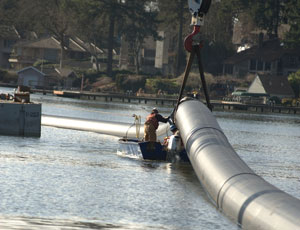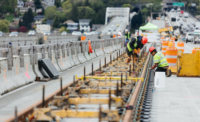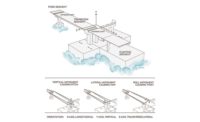What easily could have been a run-of-the-mill sewer pipeline replacement project in Oregon went from underground to underwater—creating what participants say will be the world’s first buoyant gravity line.

Now under construction, the Lake Oswego interceptor sewer boasts 17,000 ft of wastewater-carrying pipe and another 12,000 ft of attached air-filled buoyant pipe. Replacing an existing submerged concrete pile-supported pipeline built in 1963, the new system will hook to the city’s current system on both sides of the lake. It will serve 10,000 connections, about 74% of the city’s customers in the state’s Willamette Valley area. The $85-million project will involve an additional $52 million for in-lake work.
Jon Holland, project engineer for engineer Brown and Caldwell, Portland, Ore., says the idea to build a buoyant sewer came “pretty quickly” as the firm reviewed the project’s request for proposals. Challenging geological conditions underwater—hundreds of feet of elevation changes within a few yards, up to 200 ft of muddy sediment atop bedrock and the threat of seismic failure—eliminated the option of using piles. Engineers also decided that hanging a new pipeline from floats created too many obstacles for boats on the popular lake.
Circumnavigating the lake would have cost more, taken longer and added tens of thousands of feet of additional pipe, says Joel Komarek, the city’s project director. That approach also would have required six more pump stations, increased long-term maintenance and necessitated massive construction disruptions, he adds. Instead, participants opted to “make the pipe buoyant and hold it down,” Holland says. “In 30 seconds of brainstorming, we hit on a scheme that has so many advantages going for it.”
Komarek says, “What was innovative was achieving the critical grade, with the slope across the entire length of the lake necessary to match up with the existing system at upstream and downstream ends and to maintain critical slopes across the two-mile length of lake under a variety of conditions.”
The pipe falls from 12 ft underwater to 19 ft, providing plenty of clearance for motorboats, water skiers and other recreation on the lake surface. Portland-based Advanced American Construction finished installing the buoyant pipe, 18 in. to 30 in. in dia, last summer after a year of construction. “It is a unique project, but all the components were very familiar to us,” says Mike Johns, vice president of operations. “There were difficult challenges along the way, but … nothing we didn’t anticipate.” He notes lake-access issues and drilling through 200 ft of sediment as the biggest difficulties.
Crews from James W. Fowler Co., Dallas, Ore., are burying 22-in. to 42-in.-dia pipe on either end of the lake. Exiting the muddy shore, the pipe—resting on cradles supported by carbon-steel piles— connects with the buoyant pipe stretching across the center of the lake, says Mark Weisensee, project manager. Crews have drawn the lake down 24 ft to expose work areas. Work started in September and is set to finish in April.
Non-corrosive polyethylene pipe was chosen for the marine environment, but actually getting the structure to float was Holland’s next challenge. Engineers rejected the idea of filling pipes with high-density foam because of weight concerns; also, using single pipes above or underneath the sewer pipe risked flipping it over when lake levels fluctuated. Holland opted for dual air-filled pipes on either side of the sewer pipe. Ground anchors drilled 5 ft into the basalt rock bed and attached to steel rope and turnbuckles, keeping the pipe stable.
Being underwater presents obvious accessibility issues. To facilitate the work, an aluminum caisson attaches onto stainless-steel hatches in the pipe. Each hatch can be emptied of water and turned into a workable manhole by using a seal-and-pump system. To allow flexibility as the pipe expands and contracts during the lake’s 40� F seasonal temperature spread, the 1,200-ft-long jointless pipe sections are formed in a sine-wave pattern parallel to the lake bottom.
Quality control was critical “not only because this was a first-ever project, but also because failure in the lake simply wasn’t an option,” says Holland. Finite modeling, prototype building and repeat testing were the norm, he notes. Using well-known methods made the project fathomable, says Komarek. “In a lot of respects, it is an innovative combination of proven technologies,” says Holland.





Post a comment to this article
Report Abusive Comment